The man with coastal roots and a Royal Park life
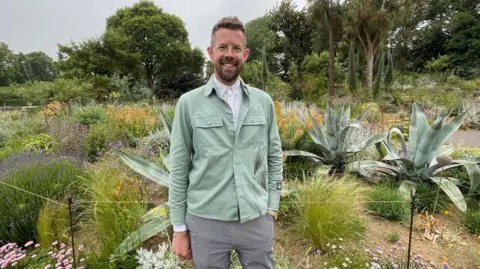 BBC/Jo Makel
BBC/Jo MakelHis passion started with a cacti collection in an East Yorkshire seaside town but it has led Matthew Pottage to the grandeur of London's historic Royal Parks and a new garden dedicated to Elizabeth II, as Jo Makel reports.
They are among the most famous green spaces in the world – Hyde Park, St James's, Richmond and Regent's - names we know, even if we've never been.
London has eight Royal Parks and, as head of horticulture and landscape strategy, Matthew Pottage is the man who oversees what grows in them.
"The bones of the landscapes are amazing," he says. "The scale, the age and the history is so exciting."
The 5,000 acres are varied. Some are sites of special scientific interest while others are immersive green spaces in the most central of city settings. With the BT Tower visible through the trees, we are breathing in the rain-enriched scent of the traditional Queen Mary rose garden in The Regent's Park.
Richmond Park, with its panoramic views of the London skyline, has oak trees which are almost 800 years old.
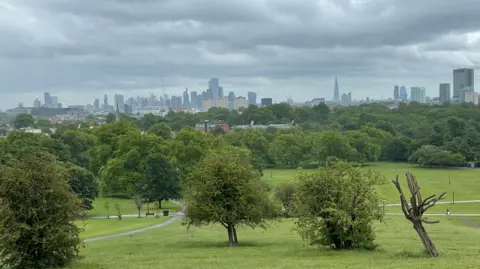 BBC/Jo Makel
BBC/Jo MakelMatthew's own history is partly why I have travelled down from East Yorkshire. His interest in gardening was inspired by his grandmother, growing houseplants and cacti in the coastal town of Withernsea.
He still pays regular visits to his home town. His parents live there and he enjoys introducing them to unusual plants, able to withstand the salt-laden winds and increasing winter rainfall.
But he was a gardening star from an early age.
He trained at Bishop Burton College, near Beverley, where aged 17, he had his first experience of media attention as the youngest-ever finalist in the Young Horticulturalist of the Year competition.
And his career soon flourished by becoming the Royal Horticultural Society's youngest curator at its flagship garden, Wisley and a regular expert on Radio 4's Gardener's Question Time.
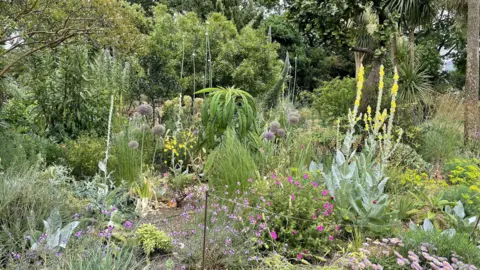 BBC/Jo Makel
BBC/Jo MakelStill in his 30s, Matthew moved to the Royal Parks and a newly created role. Despite the name and history, they are charity funded – costing around £65m a year to manage with only 15% coming from Government.
"The charity saw an opportunity to improve the horticulture right across the parks so there is quite a pressure," says Matthew.
"And where you're not following someone who has already done it, you are forging your own way, building new relationships. It's a big challenge."
But it is one he relishes, not least because he believes in the vital importance of green spaces in cities.
"Not everyone can afford their own garden or even balcony. And we knew through the Covid pandemic, people's need to be in nature and surrounded by plants is so important.
"We're understanding more the connection between nature and our mental health."
Keen to make his own mark, Matthew has ambitions to introduce a wider range of plants as well as improve sustainability and resilience.
"The climate's changed a lot and that gives challenges and opportunities. We can surprise people and do things on a scale," he says
And it seems to be working with a Mediterranean garden, featuring huge succulents and giant-headed alliums, thriving in the capital's warm micro-climate.
 BBC/Jo Makel
BBC/Jo Makel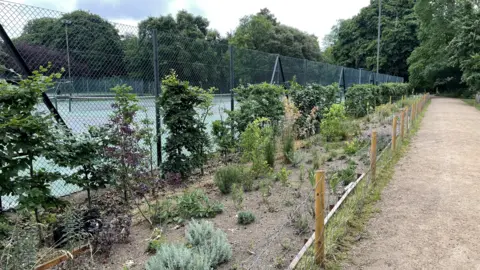 BBC/Jo Makel
BBC/Jo MakelArriving at the tennis courts we pause at a row of unassuming trial beds which line one side of the fence. But it's a new way of gardening for a special project.
Greenhouses and other buildings have been demolished and a brownfield site in Regent's Park is being transformed into two acres of new garden dedicated to Elizabeth II.
Matthew explains: "Rather than ship off all the concrete and all the hardcore that's on that site, we've crushed it, returned it into the soil and we're going to have quite a resilient garden embracing these materials..
"Growing in crushed concrete means a really high pH, fierce drainage and there are some plants that are capable of growing successfully in it. But for peace of mind we wanted to do some tests ourselves."
Resilient planting is one he feels reflects the late queen's character and other aspects of her life are planned too.
"She loved lily of the valley, it was in her wedding bouquet. She was a big fan of magnolia trees. And there will be exotic non-native plants to represent the Commonwealth."
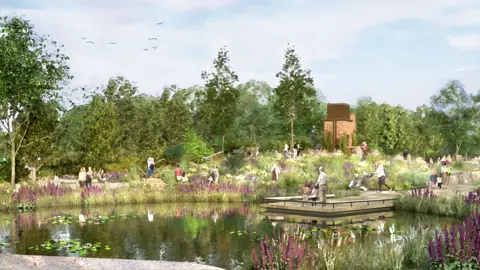 The Royal Parks
The Royal ParksThe project, announced in 2023, had already been designed and started before Matthew arrived but he's contributed to some of the choices.
King Charles III has seen the plans and there's been input from the head gardeners at Buckingham Palace and Windsor gardens.
Matthew is excited to see it come together in time for what would have been the late queen's 100th birthday next year.
"It's being part of a new legacy. The late queen was so significant and this is in central London. So for all of us, it's really quite a buzz."
Listen to highlights from Hull and East Yorkshire on BBC Sounds, watch the latest episode of Look North or tell us about a story you think we should be covering here.
